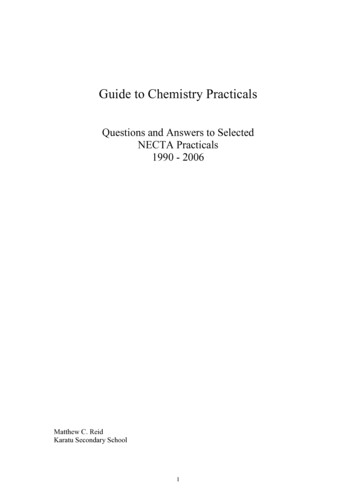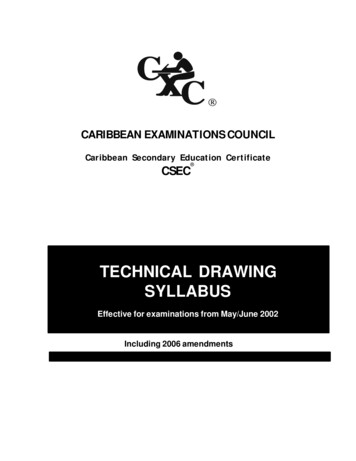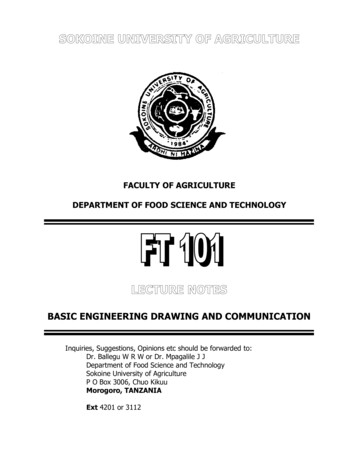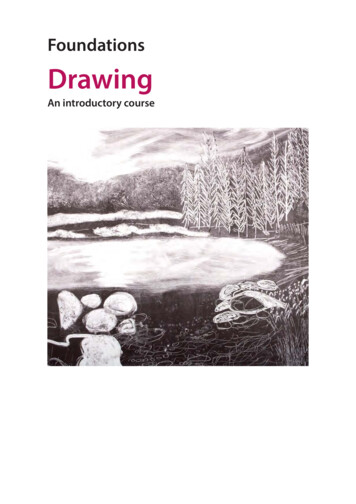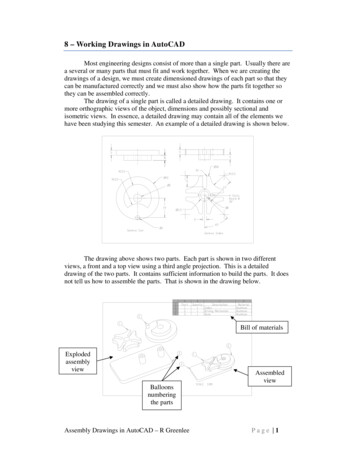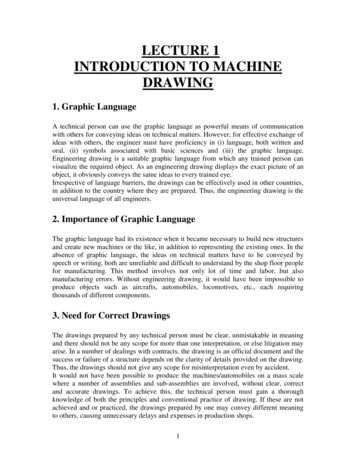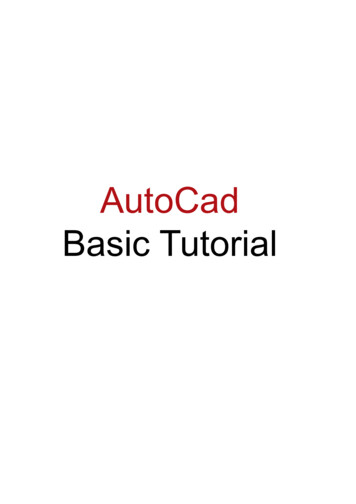
Transcription
THE NATIONAL EXAMINATIONS COUNCIL OF TANZANIASTUDENTS’ ITEMS RESPONSE ANALYSISREPORT FOR THE FORM TWO NATIONALASSESSMENT (FTNA) 2018070 TECHNICAL DRAWING
THE NATIONAL EXAMINATIONS COUNCIL OF TANZANIASTUDENTS' ITEMS RESPONSE ANALYSISREPORT FOR THE FORM TWO NATIONALASSESSMENT (FTNA) 2018070 TECHNICAL DRAWING
Published byNational Examinations Council of Tanzania,P.O. Box 2624,Dar as salaam, Tanzania The National Examinations Council of Tanzania, 2019All rights reserved.ii
TABLE OF CONTENTSFOREWORD . iv1.0INTRODUCTION.12.0ANALYSIS OF INDIVIDUAL QUESTIONS .22.1SECTION A: COMPULSORY PART .22.1.1Question1. Multiple Choice Items (various topics) .22.1.2Question 2. True or False . 122.1.3Question 3: Geometrical Construction in Plane Geometry . 172.1.4Question 4. Loci . 192.2SECTION B: SELECTION OF TWO QUESTIONS . 232.2.1Question 5: Auxiliary Views . 232.2.2Question 6: Pictorial Drawing . 272.2.3Question 7. Orthographic Projection . 303.0CONCLUSION . 344.0RECOMMENDATIONS . 354.1Syllabus Covered . 354.2Technical Professional Personnel . 35Appendix I . 36Appendix II . 37Appendix III. 38Appendix IV . 39iii
FOREWORDThe Students Items Response Analysis report for the Form Two NationalAssessment (FTNA) 2018 in Technical Drawing subject was prepared in orderto provide feedback to students, parents, policy makers and the public ingeneral on the students' performance.The Form Two National Assessment is a two-year formative evaluation which,among other things, shows the effectiveness of education system in general andeducation delivery system in particular. Essentially, students responses to theassessment questions is a strong indicator of what the education system wasable or unable to offer to students in their two years of secondary education.This booklet presents the analysis intended to contribute towards understandingsome of the reasons affecting good performance of students in the TechnicalDrawing subject. The report highlights some of the factors that made somestudents to score high or low marks in the respective questions. The factorswhich made the students to perform well include their ability to answer thequestions according to the demands of the questions as well as their knowledgein the subject matter. However, there are factors which effect some of thestudents to score high marks. Such factors include lack of knowledge inrelation to a particular concept, failure to interpret the demands of the questions,poor English Language command and inability to answer questions whichdemand the application of knowledge and skill in performing design, sketchingand drawing various machine components .The feedback provided will enable the educational administrators, schoolmanagers, teachers and students to identify proper measures to be taken toimprove students' performance in future. The National Examinations Councilof Tanzania (NECTA) will highly appreciate comments and suggestions fromteachers, students and the public in general that can be used in improvingfeedback reports.Finally, the Council would like to thank the assessors and all those whoparticipated in preparing and analysing the data used in this report as well as intypesetting the document.Dr Charles E. MsondeEXECUTIVE SECRETARYiv
1.0INTRODUCTIONThis report provides in detail the analysis of the performance for thestudents in Technical Drawing examination of Form Two NationalAssessment (FTNA) in the year 2018. The examination covered thesyllabus of the secondary Education issued in 1994 and it was set inaccordance with the examination format.A total of 1485 students sat for the technical drawing subject for the year2018, out of which 238 (16.03%) students passed and 1247 (83.97%) failed.In 2017, a total of 1269 students sat for the assessment in which 100(7.88%) students passed while the remaining 1169 (92.12%) students failed.This indicates that there is an increase of 8.15 percent of students whopassed the examination in 2018 compared to the 2017.Technical drawing paper had seven (7) questions divided in sections A andB. Students were required to answer all questions in section A and two (2)questions from section B.The performance of students in this analysis is categorised in the ranges offrom 0 to 29 percent as unsatisfactory, 30 to 64 percent as average and 65to 100 percent as a good. Table 1 and Figure 1 show overall performanceof 1,485 students who sat for Technical Drawing Examination in 2018FTNA.Table1. General students’ performance in Technical Drawing SubjectGradeRanges0 -2930- 6465 - 100PercentageRange0% -29%30% - 64%65% - 100%RemarksUnsatisfactoryAverageGood1Number of Students1,24421031
Figure 1: the general students' performance in Technical Drawing2.0ANALYSIS OF INDIVIDUAL QUESTIONS2.1SECTION A: COMPULSORY PARTSection A comprised of four (4) questions and had a total of fourty (40)marks. Students were required to answer all questions in this section.2.1.1 Question1. Multiple Choice Items (various topics)The question comprised of ten (10) items (i) – (x), which were set fromvarious topics in the syllabus. Students were required to choose the correctanswer from the four given alternatives for each item.The question was attempted by 1485 (100%) students, out of which 29percent scored from 0 to 2.9 marks, 66.7 percent scored from 3 to 6.4marks and 5.3 percent scored from 6.5 to 10 marks. Five (5) (0.30%)students performed very well by scoring 9 marks out of 10 marks. The restof the performance are as presented in Table 2.2
Table 2: The trend of students’ performance in Question 0-6465-100Average977Good781485665100TOTALThe overall performance of the students in this question was good, because71.04 percent of them scored from 30 percent and above (3-10 marks). Thisperformance suggests that most of the students were able to identify thecorrect answer from the given alternatives in at least two or more items inthe question. On the other hand there were some students who could notmake correct choices of the right answer in most of the items as illustratedin Figure 2.Figure 2: students' performance in percentage for Question 13
ANALYSIS OF THE ITEMIn item (i), the students were required to identify the uses of different typesof line. Students were required to apply the knowledge of convention usedin technical drawing to answer the question. The question was:(i) Which of the following line is used for dimensioning in technicaldrawing?ABCDThe correct answer was C. This was opted by students who had knowledgeof types of lines. Those who failed to choose the correct answer could notdistinguish between the dimension lines and direction lines. The dimensionlines have arrowheads which are placed on both ends of the lines. The aimof these type of line is to show the size of the part while the direction lineshas arrowheads at only one side and uses to indicate the component or partof the component. Moreover, alternatives B and D are directional lineswhich are used in Technical Drawing to show the specific item.Item (ii) tested the students' ability to demonstrate different types of lines.In this item, students were supposed to identify the relation between theheight of the letter and the horizontal guidelines. The question was:(ii) Horizontal guidelines are always used to get:A a uniform height for numeralB a uniform height for numbersC a uniform height for styleD a uniform height of letterThe correct answer was D: a uniform height of letters. Those who opted forA: a uniform height for numerals, B: uniform height for numbers and C:uniform height for style lacked the knowledge on letter writing andapplication of guideline in lettering during drawing. In technical drawing4
the letters are required to be written in freehand, therefore to maintain theheight and style the guide lines are used, while the numeral and symbolsmay be allowed to use drawing instruments such as drawing template.Item (iii) demanded the students to identify the application of accuratepapers which are normally used for sketching. There are various types ofpapers used in technical drawing; these can be distinguished by size andtypes. The question was:(iii) Which type of paper is commonly used for sketching accurately?A Ruled paperB Plain paperC Graph paperD A4 size paperThe correct answer was B: Plain paper. Students who opt for A: Ruledpaper and C: Graph paper failed to differentiate the type of paper used forsketching and the one which are used for normal writing. Also those whoopted for D: A4 size paper failed to distinguish between size of paper andtypes of paper used for sketching in Technical Drawing.Item (iv) tested the students' to knowledge on the rules of dimensioning ofdifferent figures. The students were required to show which is written firstwhen dimensioning the circle in Technical Drawing. The question was:(iv) The dimensioning of a circle on technical drawing must be preceded by:A a numberB a letterC a pointD a lineThe correct answer is B: a letter. Those who opted for A: a number lackedknowledge of dimensioning circle and other geometric figures. Indimensioning circle, the first digit required to start is a letter a or symbol(can be symbol R as radius or symbol ɸ as diameter) then followed bynumber. However, some students opted for C: a point and D: a lineknowing that in drawing any figure, we start with point or lines.Item (v) required the students' to explain the importance of knowing thestarting point in drawing of a locus when it moves in the path plotted by5
that point. The question measured the ability of students in plotting thelocus. The question was:(v) Why is it important to know the position of the given point and conditionof movement when drawing locus?A In order to identify the starting position and trace the path of locusB In order to trace the position of path of locus upward anddownwardC In order to use position of point and scaled ruler to trace the path oflocusD In order to use compass and starting position to trace the path oflocusThe correct answer was A: In order to identify the starting position andtrace the path of the locus. Students who chose the correct answer had theknowledge and skill in loci mechanism drawing. However, students whochose B: In order to trace the position of path of locus upward anddownward confused with the methods used to trace the locus. In drawingthe locus, the methods used is to trace path, not the position of the path.Students who opted for C: lacked the knowledge of application of scaledruler. It is not used for tracing locus students who opted for D: In order touse compass and starting position to trace the path of locus, lacked theknowledge of using the compass and point in drawing the locus. Thecompass is the tool used to draw circle and arc but it is not used for tracing.Item (vi) demanded the students to list down two common types of drawingshapes of the scale. The aim of this question was to measure theunderstanding of the students in shapes of scale which are commonly usedin drawing. The question was:(vi) The two common types of drawing scales shapes are:A triangular and curvedB flat and roughC triangular and verticalD triangular and flatThe correct alternative is D: Triangular and flat. Scale is the abbreviationwhich is used by the engineer in representing the actual object in drawingsheet. It may be reduced or enlarged depending on the needs. In6
representing an object Triangular and flat are common types of shapewhich are applicable to all standardised drawing. Students who opted for A:Triangular and curved and C: Triangular and vertical misinterpretedbetween types, shape and style of drawing scale. Vertical and curved arestyles of drawing scale. Moreover students who opted for B: flat and roughdid not have common understanding of the scale and its application as wellas type and shape as applied in technical drawing.Item (vii) tested the students' ability to identify how equal is a plane figureconsidering angles and sides. The aim of this question was to measure thestudents' understanding in geometrical and plane figures so as to build theirawareness in manufacturing and fabrication of the components. Thequestion was:(vii) A plane figure with four sides having equal sides and equal oppositeangle is called:A RhombusC TrapeziumB RhomboidD QuadrilateralThe correct answer was A: Rhombus. Students who opted for this answerhad knowledge of types quadrilateral geometrical figure (Rhombus) havingtwo same angle and four equal side and length. Those who opted for B:Rhomboid confused between the two words Rhomboid which is aparallelogram in which adjacent side are unequal while Rhombus isequilateral quadrilateral figure. However, some students who chose C:trapezium and D: Quadrilateral lacked knowledge of differentiatingbetween the figures having two sides parallel and four figures withdifferent sides thus Trapezium is a quadrilateral with one pair of sidesparallel and Quadrilateral is a polygon with four sides.Item (viii) required the students to apply knowledge of technical drawing toemphasize the convention of three dimension views to two dimensionviews in the paper. The question was:(viii) In orthographic projection sphere object are presented by:A three viewsC four viewsB one viewD two views7
The correct answer was B: one view. Students who opted for this answerhad knowledge of the shape of a sphere. That sphere is the perfect roundobject in three dimensional spaces that is the surface of a completely roundball. So when viewing front, top or side, the shape and dimension are thesame. Those who opted for A: Rhomboid and D: two views confusedbetween the three dimensions and two dimensional views. In pictorialdrawing; the plan, front and sides views are seen in one object, where byheight, length and width are indicated. Meanwhile if front, end (side) orplan views are shown in separately this object is known as orthographicdrawing. In orthographic drawing only two dimensions can be shown.These can be length and height (Front view), length and width (Plan view)or Width and height (Side or End view). However, some students whochoose C: four views lacked knowledge of the shape of a sphere wherebywhen looking on top or front or side, the shape are the similar.Item (ix) tested students' ability of analysing dimension and size of drawingsheet used in Technical Drawing Subject. The question was:(ix) In standard ISO and drawing sheet in Technical Drawing, A1 contains:A two A3B three A3C four A3D five A3The correct answer is C: four A3. This question required the students toidentify different types of paper sizes in Technical Drawing subject withreference to standard ISO and drawing sheet. The students who chose thisanswer were familiar with the convention of sheet and its size. Those whochose A: two A3 lacked the understanding size of the sheet and itsmeasurements. According to ISO, the dimension of sheet decreases as thenumber increases. Example A0 is the twice as much as A1, A1 is twice asmuch as A2, A2 is twice as much as A3 .Therefore those students whochose B: three A3 and D: five A3 lacked this concept of paper sizes and theirrelation.Item (x) tested the students' ability of understanding common types ofpictorial views in Technical Drawing Subject. The question was:8
(x) The two common types of pictorial presentation in drawing are:ABCDIsometric and Oblique drawingOrthographic and Oblique drawingAuxiliary and Orthographic drawingOrthographic and Isometric drawingThe correct answer was A: Isometric and Oblique drawing. The questionrequired the students to identify different types of three dimensional view(Pictorial view). Those students who opted B: Orthographic and Obliquedrawing and D: Orthographic and Isometric drawing could notdifferentiate between two dimensional and three dimensional views.Isometric and Oblique views are three dimensional views whereby height,width and length are indicated in one drawing, while orthographic is twodimensional views where by object can show length and height, width andlength or width and height. Furthermore, students who opted C: Auxiliaryand Orthographic drawing lacked knowledge that auxiliary is the pictorialdrawing whereby three views and dimensions can be seen in one object butdiffer in angle and nature of drawing with Isometric and Oblique. Extract1.1 and 1.2 shows a sample of a poor and good response of question 1.9
Extract 1.1: a sample of response from one of the students who managed toanswer most of the Question 1 correctly.10
Extract 1.2: a sample of poor response from one of the students forQuestion 1.11
2.1.2 Question 2. True or FalseThe question consisted of ten (10) items (i) – (x) whereby students wererequired to write TRUE if the statement was correct or FALSE if thestatement was not correct. This question was compulsory, so all studentsattempted it. The general performance in this question was good since 97.5percent of the students scored 30 percent and above (From 3 to 10 marks).The question was attempted by 1485 Students, out of which 2.5 percentscored from 0 to 2.5 marks which is unsatisfactory, 55.30 percent scoredfrom 3 to 6.0 marks which is average performance and 42.20 percentscored 65 percent and above (From 6.5 to 10 marks) which are goodresponse. Table 3 and Figure 3 represent such performance of the studentswho attempted this question.Table 3: Summarised students' scores of for Question OTALTotalNumber378226261485Figure 3: The trend of students' performance in Question 212Percentage2.555.342.2100
ANALYSIS OF THE ITEMSItem (i) tested the students' understanding of the views drawn in Technicaldrawing by identifying types of views obtained in Orthographic drawing ifit is correct or not. The question was:(i) Front elevation, plan and side elevation are drawn from orthographicdrawing.The correct response was FALSE. The students who wrote correct answerthey had knowledge on the orthographic projection that is two dimensionalviews where by object shows length and height (Front view), width andlength (Plan view) or width and height (Side view). Some of the studentswho wrote TRUE confused the orthographic drawing and isometricdrawing. They didn’t know that front, top and end views together areobtained from the pictorial drawing.Item (ii) tested the students' ability to apply the knowledge on theconstruction of equal area for a given polygons. The question asked:(ii) Square can be constructed equal in area from a rectangle.The correct answer was TRUE. The aim of this question was to test thestudents' skill in constructing various polygons in equal area in a givensquare. The students who produced correct responses had knowledge andskill on the construction of polygons. While those who wrote FALSE didnot have a skills on construction of polygon on a given square.Item (iii) tested students' ability to understand the term 'bisection' as appliedin technical drawing. The question was:(iii) Bisection of lines means to divide it into four equal parts.The correct response was FALSE. Students who wrote correct assertionhad knowledge and realized the word 'bisection of lines' which meansdivision of lines into congruent parts. And those who didn't write thecorrect answer lacked knowledge of bisection of line as applied inTechnical Drawing subject.13
Item (iv) tested students' ability on writing a write a letter in TechnicalDrawing. The aim of this question was to test students' understanding onletter writing. The question was:(iv) There should be space between the lettering words.The correct response was TRUE. The question tested the students'knowledge on the application of writing letter with space whenrepresenting some information through words in the drawing. The letterspaces displays better visual effect.Item (v) demanded the students to identify the sizes of paper in technicaldrawing.The question was:(v) The size 420mm 594mm is A2 standard sheet.The correct response was TRUE. Those students who wrote correct answerhad assertion correct had knowledge of size of paper used in TechnicalDrawing subject. Some of the students who produced incorrect alwaysconfused the A2 paper with other paper size especially A1 and A3 paper size.And this confusion of mixing paper size happened because one length of A1and A3 papers share the same dimension with A2 paper and makes thestudents to mix correct assertion of the corresponding item.Item (vi) tested the students' understanding of the meaning of Polygonfigures. A polygon figure means closed figures where sides are all linesegments and their included sides. The question was:(vi) The octagon is a polygon figure drawn with seven sides.The correct response was FALSE. The octagon is the polygon having eight(8) equal sides. The students who wrote the correct answer had aknowledge of the number of sides obtained on the polygons. Some ofstudents who wrote incorrect answer in this question were confusing thesides of polygons and their correspond names.14
Item (ix) tested the students' ability to understand the differences types ofISO scale used in Technical Drawing subjects.The question was:(ix) Metric scale as used when drawing are made in both metric andimperial.The correct answer was FALSE. Those students who select correct answerwere aware on the difference between the Imperial and Metric in the scalesubject matter. Meanwhile, some student who wrote incorrect answerTRUE, proved failure in recalling the types of scale used in TechnicalDrawing subject.Item (x) demanded the students' understanding of freehand sketch inengineering aspect.The question was:(x) Engineers use free hand sketch to convey the message for machinedesign or modification.The correct answer for this assertion was TRUE. The students who got theassertion/question correct had enough knowledge on drawing. The studentswho wrote FALSE did not have knowledge on drawing in the contest ofengineering. Extract 2.1 and 2.2 shows a sample of a poor and goodresponse of question 2.15
Extract 2.1: a sample of poor response by the student who answeredQuestion 2 incorrectly.Extract 2.2: a sample of response from one of the student who managed toanswer all parts of the Question 2 correctly.16
2.1.3 Question 3: Geometrical Construction in Plane GeometryA total of 1390 (93.6%) students attempted this question. 99.3 percent ofthe students scored from 0 to 2.5 marks, and 0.7 percent scored from 03 to6.0 marks. The students who didn’t attempt the question was 6.4 percent.Moreover, students' performance of for this question was very poor. Theoverall highest score was 3 out of ten (10) marks. Most of students failed tounderstand the demand of the question; hence they provided answers whichdo not relate to the question.The question required students to draw a circle which is tangent to line AKthough point P and touches the given circle. Those who failed to draw werelacked knowledge of drawing tangential circle with a given line. Theyfailed to know how to draw locus with a given circle at a trajectory pointsof path. For example some of the students draw an Archimedean Spiral andothers draw an Involute of circles which implies that they mixed bothtopics of Loci and Plane Geometry. The summary of students' scores in thisquestion is presented in Table 4.Table 4: A summarised groups of scores in terms of percentage of studentsQuestion OTALTotalNumber1383701485Percentage99.30.70100Some students failed to use the correct procedures to construct a tangentwhen given a point. In this question, the students were required to specifythe method of drawing a tangent which touches one circle through thegiven point. Students were unable to attempt this question correctly due tolack of knowledge and confusion with other methods of drawing a tangent.17
Figure 4: A summarised graph presents the range of scores with in terms ofpercentage of students who did the Question 3.The analysis shows that the students failed to differentiate various methodsof constructing a tangent in technical drawing. They lacked knowledge onhow to mark construction lines which helps them through a given pointwhich touches the circumference of the fist circle to get the center ofsecond circle. Extract 3.1 shows a sample of poor response by a studentwho failed to produce the relevant response in Question 3.Extract 3.1: a sample of response by student who attempted Question 3 butfailed to produce a correct answer.18
Some of the students (0.67%) had average score that is 3 and 6.5 marks.This makes the performance of the question to be averagely. No studentsscored above 6.5 marks. The students who scored 0 marks lackedknowledge and skills on how to construct a tangent to the given point andcircle. Extract 3.2 presents an answer by a student who performed Question3 well.Extract 3.2: a good performance by one of the studentswho was able to draw correct diagrams.2.1.4 Question 4. LociThis question was attempted by 1129 students out of 1485 which is equal to76 percent. 87.6 percent of students scored from 0-2.5 marks, while 9.0percent of the students scored from 3 to 6.0 marks and 3.4 percent of thestudents scored from 6.5 to 10 marks. The percent of the students whodidn’t attempt the question was 24, which is equal to 356 students.General performance of the students for this question was poor, as most ofthe students failed to understand the need of the question. The studentsrequired to construct a loci mechanism of the circle with radius ON whichrolls without sliding along straight line AB starting from point A.The table 5 presents summarised percentage groups of scores with respectto percentage of students who did the question.Table 5:A trend of Students performance in question 4.19
MarksScored0-2.53.0-6.06.5-10.0CandidatesTotal Number tionThe students who scored a 0 mark failed to differential the procedures ofconstructing a locus from a given point or specific point of a circle. Thesestudents didn’t understand how to start tracing the point N of locus AB,instead construct a locus which started tracing the path from point N to B.This analysis show that the students failed to understand the questionrequirement. Figure 5 presents the range of score in terms of percentage ofstudents who attempted this question.Figure 5: the range of score in terms of percentage for students whoattempted Question 4.The analysis revealed that most of students who attempted this questionlacked knowledge on the different methods of constructing loci. They hadno concept on how to apply epicycloid method to construct a locus.20
Extract 4.1 shows a sample of poor response by a student who provided adrawing which does not match the demand of the question and the responsewas taken from the student script.Extract 4.1: poor response by a student who provided a drawing which do notrelate to the demand of the question.Nevertheless, 3.4 percent of students scored from 6.5 to 10 marks. Thesestudents draw the completed locus and followed the principle of Locimechanism. Students in this category were knowledgeable of cycloid locus21
from other methods of constructing a locus. Those who scored highermarks mastery well the sub-topic of the Loci as sample of student shown inExtract 4.2: good response from one of the students22
2.2SECTION B: SELECTION OF TWO QUESTIONSSection B had of three (3) questions from Pictorial, Auxiliary views andOrthographic topics. Candidates were instructed to answer only two (2)questions. Each question carried thirty (30) marks making a total of sixty(60) marks for section B.ANALYSIS OF THE QUESTIONSThe analysis of performance for students in this section was categorised inthe following ranges: from 0 to 29 percent which are 0 to 8.7 marks out of30 marks as unsatisfactory, 30 to 64 percent which are 9 to 19.2 marks asaverage and 65 to 100 percent which are 19.5 to 30 marks as g
students in Technical Drawing examination of Form Two National Assessment (FTNA) in the year 2018. The examination covered the syllabus of the secondary Education issued in 1994 and it was set in accordance with the examination format. A total of 1485 students sat for th
